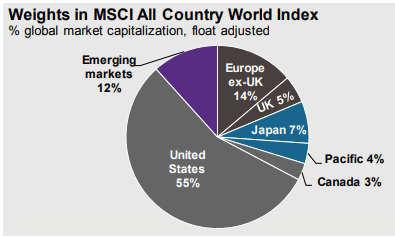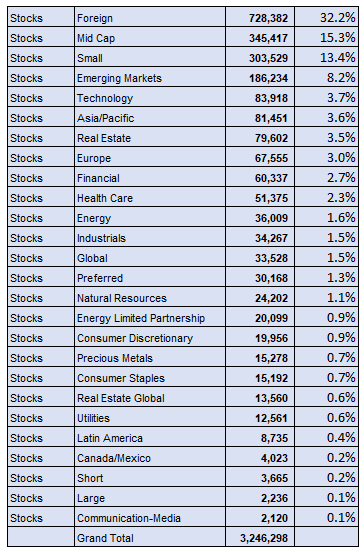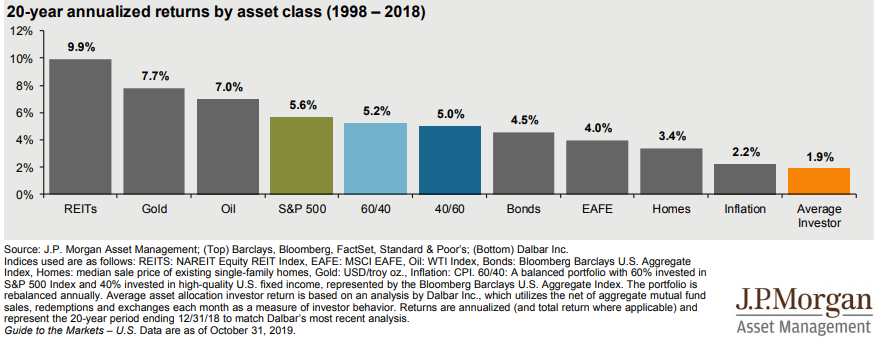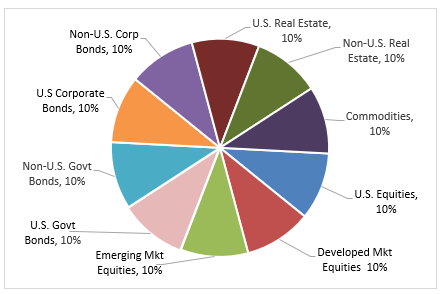The Building Blocks
Lesson 6 Module 2
Every killer portfolio has allocations to several asset classes. The way you choose to allocate your money across these classes is by far the most important decision you will make as a DIY investor. More important than security selection, or market timing, or fees & expenses.
There are roughly 50 distinct asset classes available to investors, but this course will focus on just 12 of them, because that's all you'll need to design an efficient and easy to manage portfolio.
If you want to add more than these 12 asset classes, this course will give you the pros and cons of doing so. After all, this is your portfolio, and no one else's.
Equities
This chart shows how the global equity pie is distributed. The U.S. is still the largest slice of the pie, but other markets in Europe and China for example, are gaining ground. One thing this chart tells me is that portfolios that only contain U.S. equities and ignore the rest of the world are severely tilted. It's completely up to each individual to make this kind of decision when building their portfolio, but I'm a strong advocate of global diversification, as long as it's done thoughtfully.
One other point before we move on. Equities are going to be the primary fuel for your portfolio returns, so make sure that you think it through carefully before you make your final allocation decision. I'll go into this in more depth later on in the course.
Global Equities Held by investors in ETFs
The ETF universe is huge, and growing every year. There are $3.2 trillion USD in ETFs parked in investor portfolios around the world, and 70% of that is in equity ETFs.
This table summarizes how much money is in each of the 26 categories, or asset classes, that are available to investors. Having lots of options available to build your portfolio is a good thing, but it's not necessary to research, evaluate, and select every asset class. There are ways to make this task less daunting, and I'll get to that in a later lesson.
For now, we're just reviewing the available building blocks in order to get familiar with the options available in the marketplace.
U.S. Equities
This is the largest equity asset class, which is why I have listed it first. If you want to add a growth component to your portfolio, this is the place to start. But the catch is that equities are risky. As we drill down further into the equity space you will learn about ways to diversify this asset class and possibly boost your performance a bit.
This chart from JPMorgan shows the average returns over the last 20 years for the most popular asset classes. This should give you a rough idea of the "horsepower" that each asset class can contribute to your overall portfolio returns.
Non-U.S. Equities
This is the second largest equity category, and it should not be ignored. There is something called "home bias" that can steer a U.S. investor away from non-U.S. equities, and vice-versa for a non-U.S. investor. Take care not to stray too far from building a portfolio that includes both. Tilting one way or another is fine, as long as it isn't done in extremes.
Developed Market Equities
This asset is primarily a diversified basket of large, stable, and mature European companies. As a diversifier, it belongs in every killer portfolio.
Emerging Market Equities
This is where many investors balk. Emerging markets are by definition more risky and unpredictable than domestic markets. But a killer portfolio should include this asset.
U.S. Govt Bonds
The U.S. government bond market is massive, bigger than the equity market, but it offers paltry returns in a portfolio. What it does offer is ballast against turbulence in the market and the economy. When the wheels come off the stock market, everyone runs home to Mother - Treasury Bonds. This asset class deserves a spot in your portfolio.
Non-U.S. Govt Bonds
The non-U.S. Govt Bond market is even larger. This could be because they depend on foreign lenders to finance their economic growth. When building your Killer Portfolio, don't ignore this asset class because it's an important slice of the global capital market.
U.S. Real Estate
Real Estate (REIT) is a little tricky. Technically it's part of the equity class, but it can often be a diversifier due to its high dividend payout. This asset class is well suited for investors seeking above average yields.
Non-U.S. Real Estate
This asset class usually mirrors the U.S. REIT market, except during weak dollar periods. That's why it's a good portfolio diversifier. No matter where the real estate is located, you can count on rising prices and steady income.
Commodities
This asset class encompasses everything from oil to cattle to corn and soybeans. The historical returns are poor - about 4% per year - but commodities are a good diversifier for your portfolio.
Corporate Bonds- Investment Grade
This asset is standard fare for killer portfolios. It offers returns that are higher than government paper, but lower than riskier Hi Yield bonds.
Corporate Bonds- High Yield or Junk (below investment grade)
This is an optional asset class. It's not suitable for every investor. Hi Yield bonds offer good income and some diversification in a portfolio. But this asset class is among the most risky when the market and the economy go south.
Introducing Portfolio #1. The Naive Portfolio
This portfolio is naive in the sense that it distributes its funds evenly across the 10 asset classes in this lesson on building blocks. This arrangement is a good place to start but as we move through the next few lessons you'll see why an equal weighting isn't necessarily the best weighting.
In the next lesson we'll dig deeper into these asset classes and learn how to adjust our weighting.





Leave a comment
Comment as a guest: